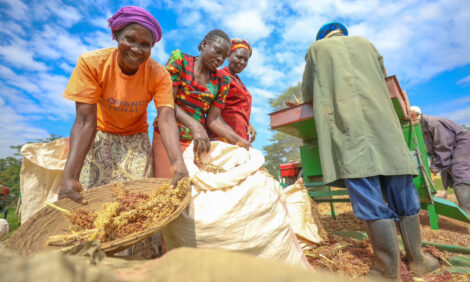



Waste of Processed Product at Retail and Consumption Level
Roughly one-third of the edible parts of food produced for human consumption, gets lost or wasted globally, which is about 1.3 billion tons per year. Food is wasted throughout the food supply chain, from initial agricultural production down to final household consumption, writes Dr Ashleigh Bright from the Food Animal Initiative.In medium- and high-income countries food is to a great extent wasted, meaning that it is thrown away even if it is still suitable for human consumption. Significant food loss and waste do, however, also occur early in the food supply chain. In low-income countries, food is mainly lost during the early and middle stages of the food supply chain; much less food is wasted at the consumer level (Gustavsson et al., 2011).

For milk (Figure 2), waste at the consumption level makes up approximately 40 to 65 per cent of total food waste in all three industrialised regions. Losses in agricultural production are significant since dairy cow illness – mostly mastitis infections – causes an approximate three to four per cent decrease in milk yield. For all developing regions, waste of milk during post–harvest handling and storage, as well as at the distribution level, is relatively high (Gustavsson et al., 2011).
Food losses - dairy products

In the UK, we waste 363,598 tonnes of milk per year, all of this is classified as ‘avoidable’ (Chapagain & James, 2011).
Main Concerns
The government–funded Waste Resources Action Programme (WRAP) has estimated that UK householders waste 30 per cent of the food they buy and of this, approximately 60 per cent is edible, or would have been were it eaten within its sell-by date. It finds that we waste 8.3 billion tonnes of food, the avoidable fraction of the food and drink waste would cost people in the UK a total of £12 billion per year, an average of £480 per household per year.
Carbon footprint
The greenhouse gas (GHG) emissions associated with avoidable food and drink waste is the equivalent of approximately 20 million tonnes of carbon dioxide per year. This is roughly 2.4 per cent of GHG emissions associated with all consumption in the UK. The most significant contributors to avoidable carbon emissions are milk waste, coffee waste and wheat products such as bread and cake (Chapagain & James, 2011).
Out of the total carbon footprint of the UK’s household waste of food and drink, 78 per cent is related to waste under the ‘avoidable’ category and 22 per cent under the ‘possibly avoidable’ category. The average carbon footprint of avoidable household food waste is 330kg carbon dioxide equivalents per person per year. This is equivalent to approximately one–third of the emissions of carbon dioxide (rather than carbon dioxide equivalents) associated with household electricity use per person in the UK (Chapagain & James, 2011).
The products with the greatest share in the carbon footprint of household food waste are presented in Figure 3. Data limitations mean that few processed foods were able to be identified, and subsequently limited emissions have been attributed to these (Chapagain & James, 2011).

In addition to the direct emissions associated with the life cycle of food, WRAP also estimate that avoidable food waste generated in the UK is responsible for emissions associated with land use change totalling 7.6 million tonnes carbon dioxide equivalents per annum (Figure 4; Chapagain & James, 2011).
Carbon Footprint of Household Food Waste in the UK ('000 Co2 eq. t/yr)

Westhoek et al. (2011) carried out a meta–analysis of 44 life cycle analysis (LCA) studies and looked at a set of possible production– and consumption–orientated scenarios on environmental benefits (GHGE, biodiversity). Global implementation of increased livestock efficiency, and a reduction in food waste (20 per cent to five per cent), resulted in the largest reduction in GHGE emissions and increase in biodiversity.
Water footprint
The water footprint is an indicator of freshwater use that looks not only at the direct water use of a consumer or producer, but also at the indirect water use.
The total water footprint of food waste in UK households is 6,262 million cubic metres per year, of which 5,368 million cubic metres per year is attributed to avoidable food waste, and a further 894 million cubic metres to possibly avoidable waste. These figures represent five per cent and one per cent of the UK’s total food water footprint, respectively.
In per–capita terms, the water footprint of total avoidable and possibly avoidable household food waste in the UK is 284 litres per person per day. By comparison, the daily average household water use in the UK (i.e. water from the tap) is about 150 litres per person per day. Out of the total household food waste, 243 litres per person per day (86 per cent) is completely avoidable and the remainder is possibly avoidable. The products with the largest share of the water footprint of household food waste are presented in Figure 5. It is seen that beef and cocoa products are the top two products in the list of water footprint of household food waste. They also rank in the top list of products in the external water footprint of the agricultural products in the UK.
Water footprint of household food in the UK (million cubic metres per year)

References
Chapagain A. and James, K., 2011. The water and carbon footprint of household food and drink waste in the UK. WWF, WRAP.
Gustavsson J., Cederberg, C., Sonesson, U., van Otterdijk, R. and Meybeck, A., 2011. Global food losses and food waste: extent, causes and prevention. FAO.
Westhoek H., Rood, T., van den Berg, M., Janse, J., Nijdam, D., Reudink, M. and Stehfest, E., 2011. The protein puzzle: The consumption and production of meat, dairy and fish in the European Union. PBL Netherlands Environmental Assessment Agency.
April 2012








